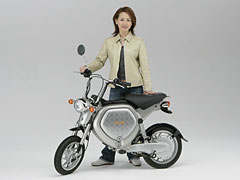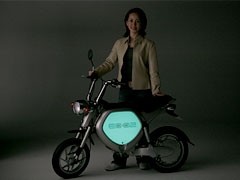 |
Yamaha Motor Co., Ltd. (the "Company") has developed a new surface finishing technology called "Film-on Graphics," designed to enable 3D and "phosphorescence" effects considered difficult to realize with conventional coating technologies. Film-on Graphics technology employs special film, prepared by printing, adhesive coating, or whatever treatment is required in the application. The film is then heated and pressed against the surface of objects -- such as parts or components -- in a vacuum chamber to give them a precisely colored and patterned decorative finish.
The new technology offers a number of advantages over conventional approaches:
| (1) |
Enables greater texture, quality and sophistication of design (such as 3D and phosphorescence expressions) considered difficult to realize with conventional technologies |
| (2) |
Provides exterior parts and components the necessary resistance against weathering and scratches |
| (3) |
Applicable on curved resins and metals alike |
| (4) |
Easily adapted to multiple, small lot and custom production needs |
| (5) |
Reduces the amount of VOC (volatile organic chemicals) in the production process to approximately one fifth that of conventional processes (per part, based on the Company's survey comparison with solvent-based paints) |
| (6) |
Allows easier recycling of parts and components |
The new technology has a broad range of application for exterior parts and components (such as covers, cowlings and fenders) of motorcycles, all-terrain vehicles (ATVs), snowmobiles and other outdoor products.
In addition, Film-on Graphics is a strategic technology for the Company. Yamaha Motor is implementing its new medium-term management plan -- NEXT50-Phase II -- which spells out management issues and operational strategies, and specifies numerical targets for the three-year period from 2005 to 2007. Film-on Graphics embodies one of the Company's principal strategies: "Creating value that differentiates Yamaha, based on proprietary technologies." Its first practical application will be in two special models in the EC-02 electric scooter series that the Company will start marketing on May 10.
 |
|
 |
Yamaha electric scooter series EC-02 with "Film-on Graphics" finish
(3D type, left, and phosphorescence type, right) |
|
 |
 |
 |
Background of Development |
|
 |
Customer needs are diversifying in all industries, and transportation equipment users are no exception, trending toward fashionable products of sophisticated design. This tendency is especially evident in the market for motorcycles, where many customers prefer a wide variety of colorful designs, gradation expressions, and other distinctive finishes on exterior parts and components. However, available colors and designs are somewhat limited with conventional coating methods. Hence, the market has been looking for new technology that can allow greater freedom of expression in design.
Meanwhile, an existing surface finishing method employing pattern-printed film -- often used in automobile interior finishes and cellular phones -- offers more colorful, textural design of higher quality. However, as it is conventionally applied, this film formation method may not press the film sufficiently to conform to resin and metallic surfaces while simultaneously meeting the need to protect exteriors against scratching and weather-related degradation. |
 |
 |
Outline of Technology |
|
 |
Film-on Graphics is innovative film coating technology that successfully addresses the drawbacks of conventional film coatings. Specifically, the Company has developed a special film and vacuum-pressure forming technology that form-fits the film over the entire object and presses it tightly to adhere to the object's surface. With Film-on Graphics, the Company simultaneously meets competing needs for colorful, high-quality design expressions and sufficient weatherability for exterior applications. Potential uses of the new technology extend beyond motorcycles to a broad range of covers, cowlings, fenders and other exterior parts and components of outdoor products in general, including ATVs and snowmobiles.
Special film
The special film used in Film-on Graphics consists of the surface, intermediate, print and adhesive layers. It not only allows 3D, phosphorescence and other new design expressions but also provides the necessary resistance against weathering and scratching of parts and components, with enough formability for covering curved objects.
Vacuum pressure film formation process
Film-on Graphics adopts a relatively simple process of placing optimally-heated film over an object in a vacuum chamber, while at the same time applying enough pressure to press it securely against the object, followed by trimming the excess. By controlling the film temperature, timing of pressure application and other factors, the film can be pressed tightly and accurately onto curved objects. The new method is expected to reduce the amount of VOC generated in conventional coating processes, which include degreasing, drying, coating, surface treatment and graphics adhesion.
 |
|
 |